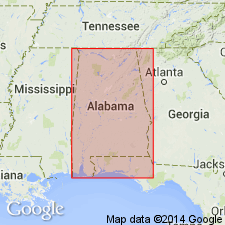
- Usage in publication:
-
- Cocoa sand
- Modifications:
-
- Biostratigraphic dating
- AAPG geologic province:
-
- Mid-Gulf Coast basin
Summary:
Pg. 65-69. Described foraminifera "from the Cocoa sand of Alabama, which is of late Eocene (Jackson) age and occurs at Cocoa P.O., Alabama."
Source: US geologic names lexicon (USGS Bull. 896, p. 479-480).
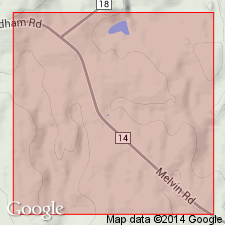
- Usage in publication:
-
- Cocoa sand member*
- Modifications:
-
- Principal reference
- Dominant lithology:
-
- Sand
- Marl
- AAPG geologic province:
-
- Mid-Gulf Coast basin
Summary:
Pg. 1387-1388. Cocoa sand member of Jackson formation. Fine yellow sand with soft white calcareous lumps and large irregular lumps of hard yellow sandy marl. Thickness 6 feet. Grades up into ZEUGLODON-bearing bed (which consists of gray or drab sandy and argillaceous marl with harder edges and irregular calcareous concretions, very argillaceous in upper part, and 11 feet thick). Separated from underlying PERIARCHUS-bearing bed (so-called SCUTELLA bed) by 30 to 50 feet of light-green plastic calcareous clay with shells, in part micaceous and sandy. Named from abandoned country post office called Cocoa, which many years ago stood in SW/4 sec. 13, T. 11 N., R. 5 W., Choctaw County, Alabama, about 2.5 miles east of Melvin, on road to Gilbertown. Probably represents part of Yazoo clay of Mississippi. [Age is late Eocene.]
[Cooke now regards this sand as represented in lower part of Yazoo clay of Mississippi (Personal commun., Feb. 1935).]
Source: US geologic names lexicon (USGS Bull. 896, p. 479-480).
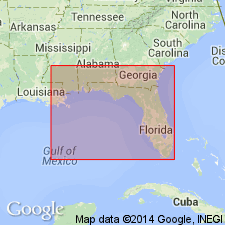
- Usage in publication:
-
- Cocoa sand member
- Modifications:
-
- Revised
- AAPG geologic province:
-
- Mid-Gulf Coast basin
Summary:
Pg. 1315 (fig. 1); C.W. Cooke and others, 1943, GSA Bull., v. 54, no. 11, chart 12; [U.B. Hughes], 1940, Mississippi Geol. Soc. [Gdbk.] Field Trip Feb. 10 and 11, second day's field trip, p. 2.
Referred to as Cocoa sand member of Yazoo clay. [Recognized in southwestern Alabama and eastern Mississippi. Age is late Eocene.]
Source: US geologic names lexicon (USGS Bull. 1200, p. 866).
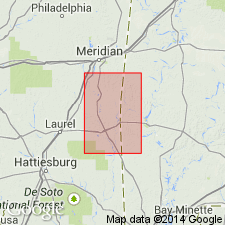
- Usage in publication:
-
- Cocoa sand member*
- Modifications:
-
- Mapped
- AAPG geologic province:
-
- Mid-Gulf Coast basin
Summary:
Cocoa sand member of Yazoo clay. In Choctaw County, Alabama, member consists of lower marly fine-grained sand phase and upper coarser calcareous sand phase. Lower phase, 10 to 20 feet thick, is clayey and marly fine-grained micaceous sand that is bluish gray or greenish blue on fresh outcrop. Upper phase, 20 to 50 ft thick, is medium-grained calcareous sand containing irregular ledges of glauconitic limestone and marl at top. [Age is late Eocene.]
Source: US geologic names lexicon (USGS Bull. 1200, p. 866).
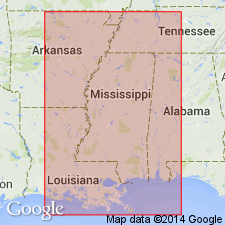
- Usage in publication:
-
- Cocoa sand member
- Modifications:
-
- Areal extent
- AAPG geologic province:
-
- Mid-Gulf Coast basin
Summary:
Pg. 1838 (fig. 6), 1839. Cocoa sand member of Yazoo clay. In Mississippi and Alabama, Cocoa sand member is overlain by Pachuta marl member and underlain by North Creek clay member (both new). [Age is late Eocene.]
Source: US geologic names lexicon (USGS Bull. 1200, p. 866).
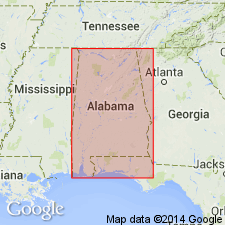
- Usage in publication:
-
- Cocoa Sand Member
- Modifications:
-
- Overview
- AAPG geologic province:
-
- Mid-Gulf Coast basin
Summary:
Cocoa Sand Member of Yazoo Clay (Jackson Group) as used by the AL Geological Survey is dusky-yellow calcareous, fossiliferous fine- to medium-grained, firm massive sand. Lithology may vary over short distances to include sandy limestone, calcareous sand or greenish-gray, micaceous, calcareous, very clayey sand. Present in southwest AL. Thickness ranges from 5 ft on the Conecuh River to 50 ft in Choctaw Co. Underlies Pachuta Marl Member and overlies North Twistwood Creek Clay Member. All members of the Yazoo Clay interfinger with the Crystal River Formation to the east. Jackson Group is undifferentiated downdip in the subsurface. Age is late Eocene (Priabonian).
Source: GNU records (USGS DDS-6; Reston GNULEX).
For more information, please contact Nancy Stamm, Geologic Names Committee Secretary.
Asterisk (*) indicates published by U.S. Geological Survey authors.
"No current usage" (†) implies that a name has been abandoned or has fallen into disuse. Former usage and, if known, replacement name given in parentheses ( ).
Slash (/) indicates name conflicts with nomenclatural guidelines (CSN, 1933; ACSN, 1961, 1970; NACSN, 1983, 2005, 2021). May be explained within brackets ([ ]).

